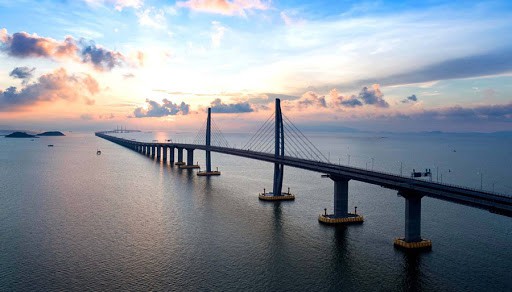Dr Kefei Li of Tsinghua University in China, one of our keynote speakers for Concrete 2021, has shared with us some details about his forthcoming presentation that will involve the impressive Hong Kong-Zhuhai-Macau Bridge.
His presentation will cover the standard and practice of durability design, control and planning in China, based on the newly issued Technical Guide for Durability of Concrete Structures of the Chinese Civil Engineering Society (CCES). The guide covers the durability aspects of concrete structures through their life cycle: the conceptual design, preliminary design, detailed design, construction, and service phases. The background of the technical guide, according to Kefei Li is the urgent need of the ongoing massive construction of concrete infrastructure in China to ensure these facilities achieve both expected durability performance and rational life cycle cost.
“General provisions are given to ensure the resistance of structures against environmental actions, serving as a basis for durability consideration in conceptual and preliminary design phases,” he said.
“The environmental actions are classified into different types and densities following the typical deterioration mechanisms. Based on state-of-the art scientific knowledge and engineering practice, the technical requirements for durability in the detailed design phase are formulated for concrete materials, steel element details and protection measures.”
To achieve the same design working lives, the designer can make the choice between a single barrier option or multi-barrier option. The former uses structural concrete as the single resistance barrier to the deterioration processes while the latter, in addition to structural concrete, employs protection materials and techniques including surface hydrophobic treatment, surface layer corrosion inhibitor and electrochemical protection of steel. Also, at this stage the preliminary maintenance planning is implemented for the different elements.
“For durability control in the construction phase, the crack control is highlighted, and good practices are provided to avoid cracking originating from thermal shrinkage, autogenous shrinkage and drying (plastic) shrinkage during the early age,” Kefei Li explained. “For the service phase, an interactive framework of life cycle management of durability performance is set up, including the durability inspection, durability assessment and redesign, and the recommended maintenance techniques.”
Under this framework, the maintenance planning is to be updated from the inspection results and durability assessment. In his presentation, Dr Kefei Li will introduce China’s sea-link project that was completed in 2018, to demonstrate the different elements of durability design, control and planning so it’s one to watch out for at Concrete 2021!
Keynote speaker for Concrete 2021, Dr Akio Kasuga, believes we are facing a new period of uncertainty about the future because, COVID-19 aside, calls for global action on climate change are accelerating. Dr Kasuga is an executive vice president and the chief technical officer of Sumitomo Mitsui Construction in Japan and the President of fib from 2021 to 2022.
Having designed and built over 200 bridges, Dr Kasuga has developed many new bridge technologies such as extradosed bridges and butterfly web bridges, and has more than 80 patents. He has also received recognition for his work with ¬ b outstanding structures awards in 2006 and 2018 and the Eugene Freyssinet Trophy in 2013.
He said that in order to reduce carbon emissions of concrete structures, low carbon technologies are becoming more and more necessary.
In his presentation for our upcoming virtual biennial conference in September, Dr Kasuga will discuss a project he was involved in, a bridge that used zero cement concrete and non-metallic reinforcement.
“The zero-cement concrete can reduce CO2 emissions up to 70% compared with conventional technology,” Dr Kasuga said.
“And the non-metallic reinforcement used, aramid fibre tendon, has no impact on the deterioration of concrete.”
Building much longer lifetime concrete structures leads to ultra-high durability, according to Dr Kasuga, and reduces the necessity for conservation work, meaning less CO2 emissions afterward.
“We, as concrete designers, engineers and researchers, have to continue to push for low carbon technologies until 2050 as concrete is an essential material for human prosperity,” he said.
“And the non-metallic reinforcement used, aramid fibre tendon, has no impact on the deterioration of concrete.”
Building much longer lifetime concrete structures leads to ultra-high durability, according to Dr Kasuga, and reduces the necessity for conservation work, meaning less CO2 emissions afterward.
“We, as concrete designers, engineers and researchers, have to continue to push for low carbon technologies until 2050 as concrete is an essential material for human prosperity,” he said.


